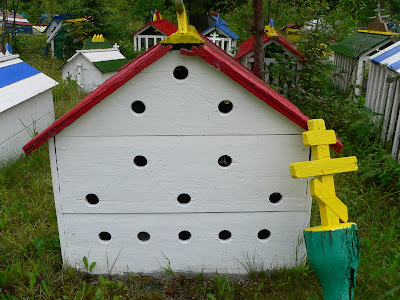Sunday, July 27, 2008
Eklutna
Today we head northeast out of Anchorage on the Glenn Highway and stop at a small native village with an interesting historical cemetery, a sacred burial ground of the Athabascans with more than eighty spirit houses or grave houses.
This is the site of an early Indian settlement that was later visited by Russian Orthodox missionaries. Eklutna, in the native language means "two objects."
This Athabascan village shows a blending of the native culture and the influences of Russian Orthodox missionaries. On one hand, the Athabascan cemetery shows their custom of the spirit houses, which have been used here for over a thousand years. On most of the houses you do not see a name or dates for their departed. In the native culture, artistic expression was and still is used as a written language. They knew who their loved ones were by the design and color of the spirit houses.
The other culture in Eklutna is the Russian one of St. Nicholas Russian Orthodox church, which is still the largest Christian faith in Alaska today.
Built in 1794, this church and the adjacent hand-hewn Siberian prayer chapel and cemetery are still used today.
After Russia sold Alaska to America, many of the Russians left, leaving what had begun as a Russian parish to become mostly Athabascan.
Unique to the Athabascan people, spirit houses were placed over traditional graves and contained personal items to help the spirit in the next world.
Families build these of wood and paint them in traditional Athabascan colors. They represent a cultural activity as a grave stone does for us.
Chiefs or leaders were buried with a spirit house surrounded by a fence.
A spirit house for a child is smaller.
A fenced house is one from another tradition and does not contain a true Athabascan.
Traditionally, Athabascan people buried their loved ones after cremation, placing their remains in a box along with favored tools and were brought potlatch food within a period of one year. After a year, the spirit is believed to depart to the other world.
This house is particularly interesting with it's clear windows--
--revealing an Alaskan flag, religious pictures, and a crochet hook and bag.
A spirit house inside a larger one is a woman with child buried together.
The church was closed today so here we peek through the window.
Friday, July 25, 2008
Alaskan Native Heritage Center
The Alaska Native Heritage Center in Anchorage displays a number of traditional village sites around the small Lake Tiulana.
These sites open a window into the past with actual native hosts at each site telling about traditional and contemporary ways of village life. Traditions that helped people thrive in Alaska's rich environment.
Many aspects of native life are showcased here-- films, native storytelling and dancers, and many artisans making and showing native products.
Houses were made of the most abundant materials close by: wood, mud, grass, whale bones and various hides and skins, and were often partly underground.
The Qasgig or larger men's house between two women's houses. Men and older boys lived and worked here and this was the community house.
The women brought food in the evening and joined in the singing and festive events here. It was twice as large as the women's house. All women lived in the Ena, or women's house. The young girls were taught to weave baskets, mats and sew skins there.
Judy trying on an Aleutian whaling helmet, used by hunters in their kayaks to keep the sun and water from their face. The forward-facing ridge or groove was a guide for throwing the harpoon straight ahead.
Natives lived in massive spruce and cedar clan houses--
Subscribe to:
Posts (Atom)





















































